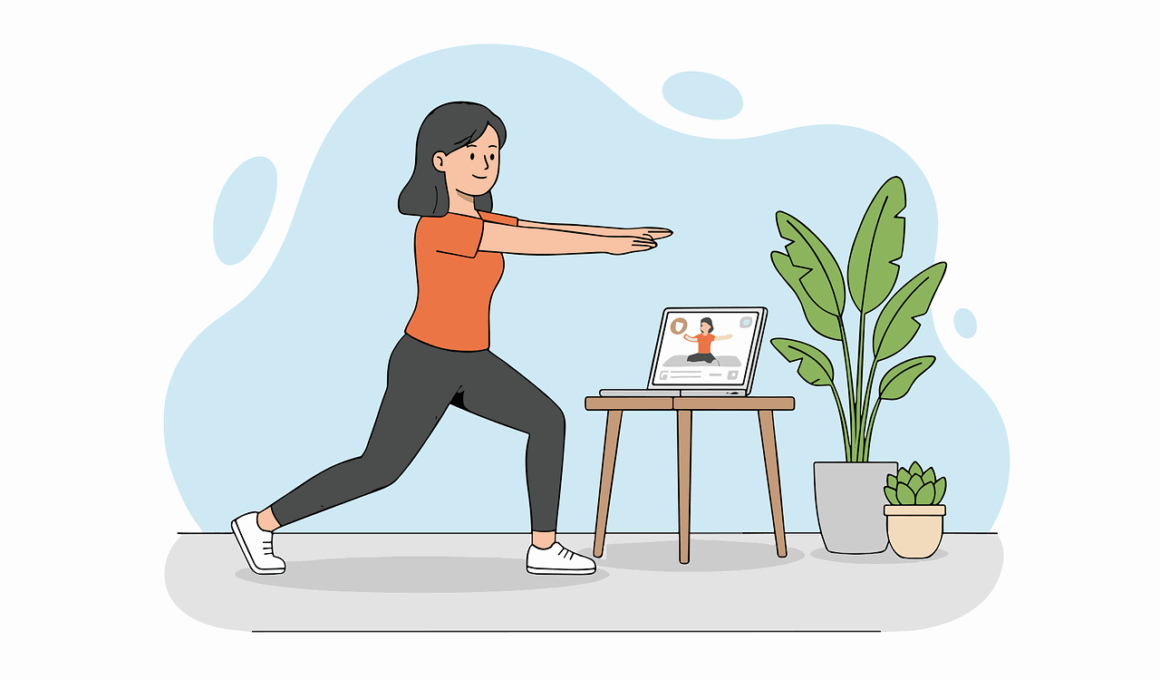Recognizing Signs of Overexertion During Home Workouts
Overexertion can significantly diminish the benefits of workouts at home, leading to injuries. Understanding its signs becomes crucial. When your body signals these warnings, listening is essential. Common indicators include persistent fatigue, which differs from normal tiredness. This sensation suggests your body has reached its limits. Watch for muscle pain, as this can be a prelude to overexertion. Pain that intensifies or is unusual should never be ignored. Also, monitor your heart rate—elevated baseline levels signal potential problems. Overtraining can shift focus from physical development to potential health risks, making recovery challenging. Additionally, dizziness or light-headedness might occur, pointing to inadequate recovery or dehydration. Regularly checking hydration status helps avoid this sign. If you’re ever short of breath or experience swelling in the limbs, stop exercising and consider consulting with a professional. Anxiety and irritability should also be noted; they might indicate your body is protesting against excessive strain. Seek balance in your home workouts to enhance results and well-being. Proper pacing is essential to ensure health during exercise routines, reinforcing your dedication to achieving fitness goals effectively.
Monitoring your energy levels is an essential practice when engaged in home workouts. When fatigue sets in, it’s crucial to acknowledge that your body may be overworked. Often, traits such as increased irritability and anxiety can surface and signify that you’re pushing too hard. Additionally, feeling exhausted after simple tasks might indicate you need to reevaluate your routine. To ensure you stay safe in your exercises, consider taking longer breaks and focusing on maintaining proper hydration, as dehydration greatly contributes to fatigue. Setting realistic goals also helps prevent overexertion. Ensure you incorporate variety into your routines so that specific muscle groups are not consistently strained. Scheduling workouts that allow muscle recovery is vital, as it facilitates growth without prompting overexertion. Also, discuss your plans with a fitness professional to create a balanced strategy that meets your needs. Remember that quality always outweighs quantity; focusing on form and technique is more beneficial than merely completing sets at the expense of your health. Listen to your body’s response to your workout; your body will communicate its limits if you pay attention.
Understanding the Role of Warm-ups
One often overlooked aspect of avoiding overexertion is the importance of proper warm-ups before workouts. Engaging in targeted warm-up exercises prepares your body for the activity ahead. Gradually increasing heart rates and blood flow ensures your muscles are ready to work and thus prevents injuries. Many individuals may skip this step, believing they can jump straight into their routines. However, proper warm-ups stimulate your cardiovascular system and boost flexibility. Simple dynamic stretches or light aerobic exercises can make a substantial difference. Aim to warm up for at least five to ten minutes before beginning your workout. It’s not just about warming up; cooldowns play a vital role too. Cooling down helps your body transition back into rest by gradually reducing heart rates and returning muscle temperatures to normal. Ignoring cooldowns leads to muscle soreness and increases the risk of injury. Both warm-up and cooldown periods should be incorporated into your home workouts, as they significantly enhance performance and recovery. Effective techniques like yoga can aid this process beautifully, promoting mindfulness and body awareness. Ultimately, prioritizing these practices cultivates a healthier approach to your fitness journey.
Incorporating rest days into your home workout schedule is non-negotiable for effective recovery and preventing overexertion. Rest periods allow your muscles time to recover, repair, and grow stronger. Many fall into the trap of believing that without daily exertion, they are not making progress; however, this could not be further from the truth. Rather, consistent training without adequate rest often leads to burnout or injury. Depending on your fitness level and intensity, plan at least one or two rest days per week effectively. On rest days, consider light activities such as walking, gentle stretching, or yoga to maintain mobility without straining your body. Scheduling rest days recognizes the vital role they play in enhancing your performance. Moreover, stress management is essential, as psychological factors influence physical performance. Engaging in relaxation techniques or mindfulness practices on rest days can significantly enhance your workouts’ effectiveness in the long run. Aim to balance effort with the necessary downtime to optimize your fitness goals. Always listen to your body’s signals when it craves rest; obeying these cues will streamline your journey toward well-being and strength.
Proper Nutrition and Hydration
Nutrition and hydration are crucial components that support physical performance and help recognize signs of overexertion. Consuming a balanced diet rich in nutrients ensures your body has the energy it needs to perform without excessive strain. Fueling up on carbohydrates, proteins, and healthy fats is essential for optimal functioning. Additionally, ensure you’re consuming adequate vitamins and minerals. Moreover, hydration plays a significant role in your performance, as even mild dehydration can lead to fatigue, dizziness, or disorientation. Aim for at least eight glasses of water daily, and adjust that amount based on activity intensity and environment. Before your workouts, consume hydrating foods and fluids to maximize pre-exercise hydration. During workouts, hydrating with water or electrolyte-rich beverages replenishes lost fluids and supports performance longevity. After workouts, focus on recovery by replenishing lost nutrients with balanced post-workout meals. Examples include fruits, vegetables, lean proteins, and whole grains, which help rebuild muscles. Recognizing when your body craves nutrition or hydration can significantly enhance workout effectiveness and reduce overexertion risks. Make conscious choices to nourish your body with wholesome foods, contributing to your overall wellness.
Adjusting workout intensity is a critical skill in home fitness to prevent overexertion effectively. Many enthusiasts fall into the pattern of exercising at a consistently high intensity, leading only to fatigue and discouragement. Instead, varying your workout intensity helps minimize risks while maximizing gains. Consider implementing interval training, which alternates between periods of high intensity and lower-intensity recovery periods. This strategy allows you to challenge yourself while still granting your body necessary rest intervals. Additionally, utilizing different training concepts, such as circuit training or strength training with lighter weights, further diversifies your routine while preventing monotony. Particularly, adopting a gradual approach when entering new fitness levels reduces the chance of injury. Listen to your body’s feedback during workouts, as it will indicate what intensity works best for you. Learning to communicate effectively with your body will ensure you’re aware of signs that warrant a break or adjustment. Ultimately, this attention to intensity and variation cultivates an all-rounded workout experience, emphasizing safety, enjoyment, and continued growth. Establish a habit of tuning in to your body to better discern when it’s the right moment to elevate or dial back your efforts.
Conclusion and Final Tips
In conclusion, recognizing signs of overexertion during home workouts is essential for maintaining a balanced and effective fitness routine. Each element we’ve discussed aids in this understanding, from recognizing fatigue and discomfort to adhering to workout intensity and proper nutrition. Remember that fitness is a journey, not a race, and embracing patience contributes to your overall success. Moreover, keeping a workout journal can greatly assist in tracking your energy levels and physical responses to particular exercises. Creating a space for reflection allows you to become mindful of your physical state and adapt your routines accordingly. Sticking to integrated approaches like warming up and cooling down enhances your performance and promotes longevity in your fitness journey. Finally, consider joining fitness communities online for support and motivation. Interacting with others who share similar interests contributes positively to your mental outlook on fitness. Use this collective wisdom to enhance your overall experiences. Prioritize your health over immediate results, and remember that progress often stems from well-balanced dedication. Protect your well-being, listen to your body, and enjoy every step as you cultivate a healthier lifestyle from home.
Social Media is a great avenue for fitness inspiration, connecting you with others who understand your struggles.


